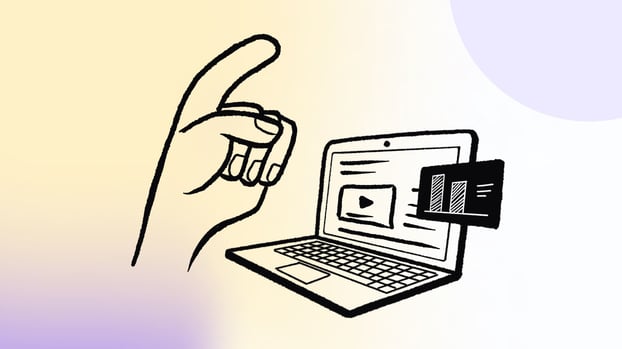Choosing the right ITSM tool is a key step in shaping how IT teams deliver services and support business goals. The market is evolving quickly, with vendors expanding features to cover automation, AI-driven support, and integrations that go beyond IT. For organizations planning their 2026 IT strategy, understanding what each tool offers is critical.
According to a study by Harvard Business Review, organizations that improved their ITSM practices reported heightened data security (63%), better alignment of IT with business priorities (59%), stronger support for remote work (58%), and improved employee productivity (53%). One key factor in these outcomes is adopting an integrated ITSM platform, which reduces complexity and provides a foundation for long-term digital transformation.
In this complete guide to ITSM software, you’ll find twelve standout tools projected to lead in 2026 — each with different strengths, use cases, and trade-offs.

Methodology
Before we get started, a quick note: InvGate builds and offers IT Service Management and IT Asset Management solutions, making us an active player in this software market.
Some vendors in this article are our competitors. Even so, we aim to deliver accurate, honest, and practical information that helps you make the best decision.
Our evaluations draw from publicly available sources — vendor websites, product documentation, user reviews on platforms like Gartner Peer Insights, G2, and Capterra, analyst reports, and hands-on testing or demos when available. We assess each solution based on functionality, pricing (where made public), integrations, user experience, and support quality.
The information here is accurate as of November 2025. We'll review this content regularly to stay current with product updates and market developments.

Quick answer - ITSM tools at a glance
These are the most important IT Management platforms in the market. In the following sections, we will break them down for you.
| Hosting | Free Trial |
Pricing
|
Customer review score (Gartner)
|
|
| InvGate Service Management | Cloud and on-premise | Yes (30 days) |
Starts at $17 per agent per month.
|
4.8
|
| ServiceNow ITSM | Cloud and on-premise | No |
Not disclosed
|
4.3
|
| Jira Service Management | Cloud and on-premise | Yes (7 days) |
Standard: $19
Premium: $47.82 |
4.4
|
| SolarWinds Service Desk | Cloud | Yes |
Essentials: $39
Advanced: $79
Premier: $99
|
4.4
|
| SysAid | Cloud and on-premise | No |
Not disclosed
|
4.5
|
| Freshservice | Cloud | Yes |
Starter: $19
Growth: $49 Pro: $99 |
4.3
|
| Ivanti Neurons for ITSM | Cloud and on-premise | Yes | Not disclosed |
4.2
|
| BMC Helix ITSM | Cloud and on-premise | No |
Not disclosed
|
4.3
|
| TOPdesk | Cloud | Yes (30 days) |
Starts at ~$68 /per agent/month
|
4.5
|
| TeamDynamix ITSM | Cloud | No |
Not disclosed
|
4.6
|
| EasyVista | Cloud and on-premise | No |
Not disclosed
|
4.9
|
| ManageEngine Service Desk Plus | Cloud and on-premise | Yes (30 days) | Starts at $13 /per agent/month (Cloud) |
4.4
|
How to choose an ITSM tool
To make the process easier, here are five practical steps to guide your decision.
-
Define your requirements: Start by identifying what you need the tool to achieve. Clarify which ITSM processes you want to manage — such as Incident, Request, or Change Management — and how mature your current practices are. Consider your team’s size, daily workload, and improvement goals.
For instance, if your main priority is reducing response times, look for automation and reporting features that help track performance and speed up resolution.
-
Identify key integrations: An ITSM solution should connect smoothly with the systems your team already uses. Integrations with Asset Management tools, monitoring software, or communication platforms can save time and reduce errors caused by duplicated data.
-
Consider cloud deployment: Deciding between a cloud-based or on-premises solution affects both cost and maintenance. Cloud-based ITSM solutions often offer automatic updates, scalability, and easier access for distributed teams. On-premises options, on the other hand, may be suitable for organizations with strict data control requirements.
-
Evaluate the total budget: When comparing tools, look beyond license costs. The total budget should include implementation, onboarding, training, and ongoing support. A total cost of ownership (TCO) estimate can help you assess long-term value and avoid surprises later.
-
Test with real use cases: Before committing, test the tool with real scenarios from your daily operations. Run a few common workflows to see how intuitive the interface feels, how quickly it adapts to your processes, and how it performs under typical workloads. Involving actual users in these tests is a great way to gather practical feedback and see whether the platform truly fits your organization’s needs.
ITSM tools reviewed (12 options)
1. InvGate Service Management
InvGate Service Management is a comprehensive, ITIL-aligned ITSM solution designed for fast onboarding, ease of use, and enterprise-grade scalability. With an 86.96% positive ease-of-use perception (well above industry leaders like ServiceNow) it helps organizations streamline IT processes and accelerate time-to-value, whether deployed on-premises or in the cloud.
Powered by AI-driven automation and self-service, InvGate Service Management enables IT, HR, Facilities, and other departments to work smarter. AI helps classify, prioritize, and route tickets instantly, surface relevant knowledge articles, and even suggest resolution actions, reducing ticket volumes by up to 15% while improving user satisfaction.
InvGate also earned recognition as a 2025 Gartner Peer Insights Customers’ Choice, with an average rating of 4.9/5 across 73 reviews and a 94% “willingness to recommend” score.
InvGate Service Management features
-
AI-powered automation: Automatically categorize and route tickets, recommend solutions, and identify trends before they escalate—reducing manual work and speeding up resolution times.
-
No-code workflow builder: Drag-and-drop components to design complex, multi-step workflows with approvals and automation — no technical expertise required. Pre-built templates for IT, HR, and Facilities speed up deployment.
-
AI-enhanced self-service: Offer users personalized, intelligent service portals that proactively suggest answers, guiding them to resolution without logging a ticket.
-
Reporting and analytics: Create detailed dashboards and export flexible reports to track performance, identify improvement opportunities, and demonstrate IT’s business value.
-
Unified ITSM + ITAM: Natively integrates with InvGate Asset Management for real-time asset visibility, impact analysis, and end-to-end service resolution.
-
Enterprise-ready integrations: Connect with identity management, monitoring, and collaboration tools via robust APIs and pre-built connectors to support complex environments.
-
Post-sale support & customer success: Rapid go-live with hands-on onboarding, dedicated success managers, and continuous optimization support from product experts.
InvGate Service Management pricing
InvGate offers flexible pricing plans that scale to meet the unique needs of your organization.
- Starter at $17/agent/month up to 5 agents.
- Pro at $40/agent/month from 6-50 agents.
- Enterprise offers custom pricing for larger organizations.
We also offer a free trial, so you can try our software before committing to a plan.
InvGate Service Management user reviews and ratings
- Gartner Peer Reviews score: 4.8
- G2 score: 4.6
It's the most thought-through ServiceDesk tool I have seen so far. It feels like somebody sat down and said "How can I make the most accessible, yet extensive, ServiceDesk tool for both agents and users."
User review from Gartner, Head of ITSM
2. ServiceNow ITSM
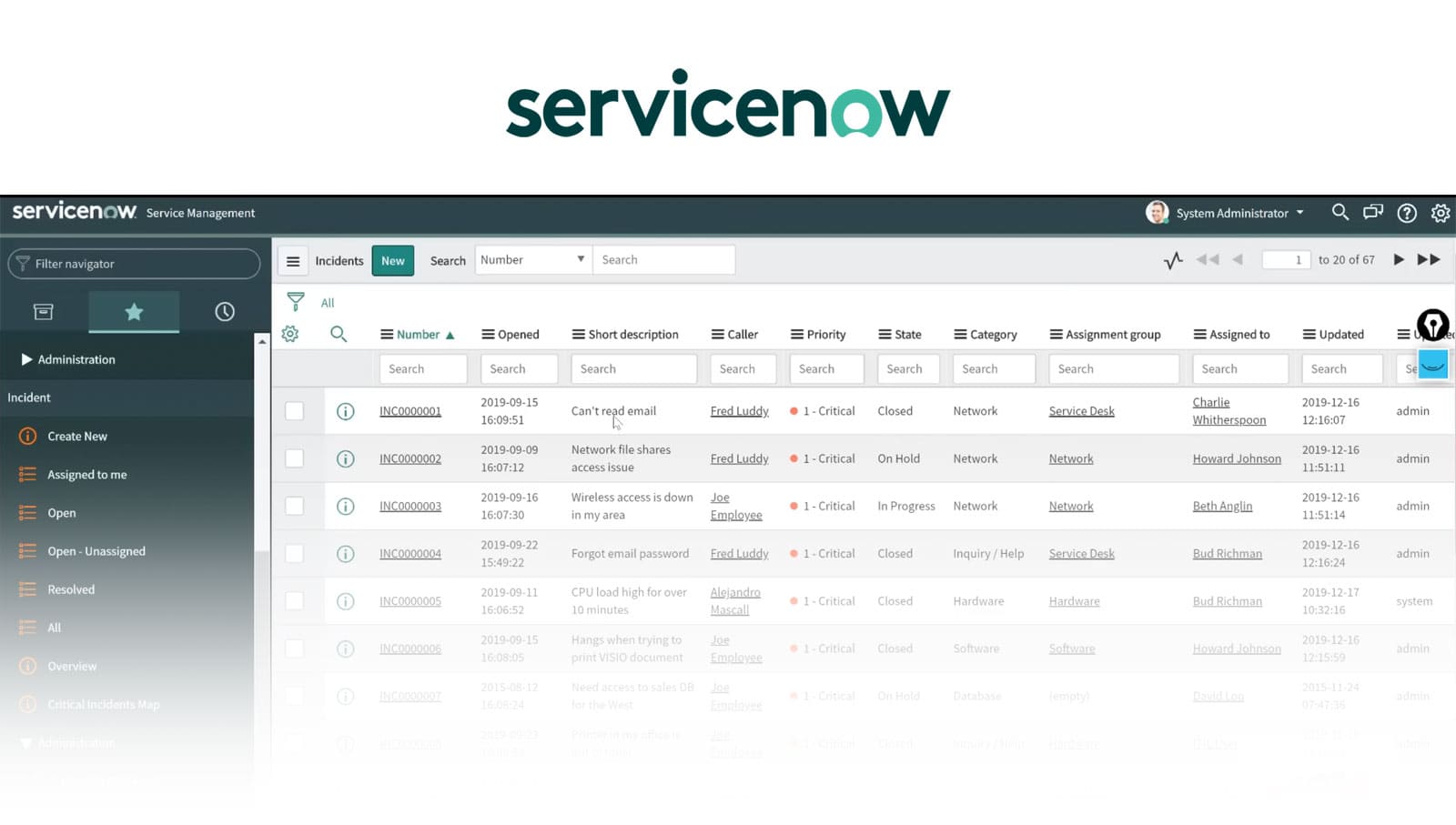
ServiceNow® ITSM is one of the most widely recognized platforms used by enterprises and large organizations. Initially focused on IT Service Management (ITSM), it has since expanded into areas like HR, customer service, and security operations.
Known for its scalability, it suits businesses that need a highly configurable Service Management platform. It's primarily cloud-based and integrates with a broad range of third-party applications.
ServiceNow features
The following features are listed on the platform’s official product page (accessed November 2025).
- Incident Management (log, route, resolve incidents).
- Change and Release Management.
- Request Management and service catalog.
- Asset and Configuration Management (visibility of infrastructure/resources)
- Analytics, reporting, and AI-powered workflows.
ServiceNow pricing details
ServiceNow doesn’t disclose its pricing. We can tell you that costs depend on several factors: the chosen modules, the number of users, the type of licenses acquired, and the level of support.
ServiceNow user reviews and ratings
- Gartner Peer Insights score: 4.3
- G2 score: 4.4
3. Jira Service Management
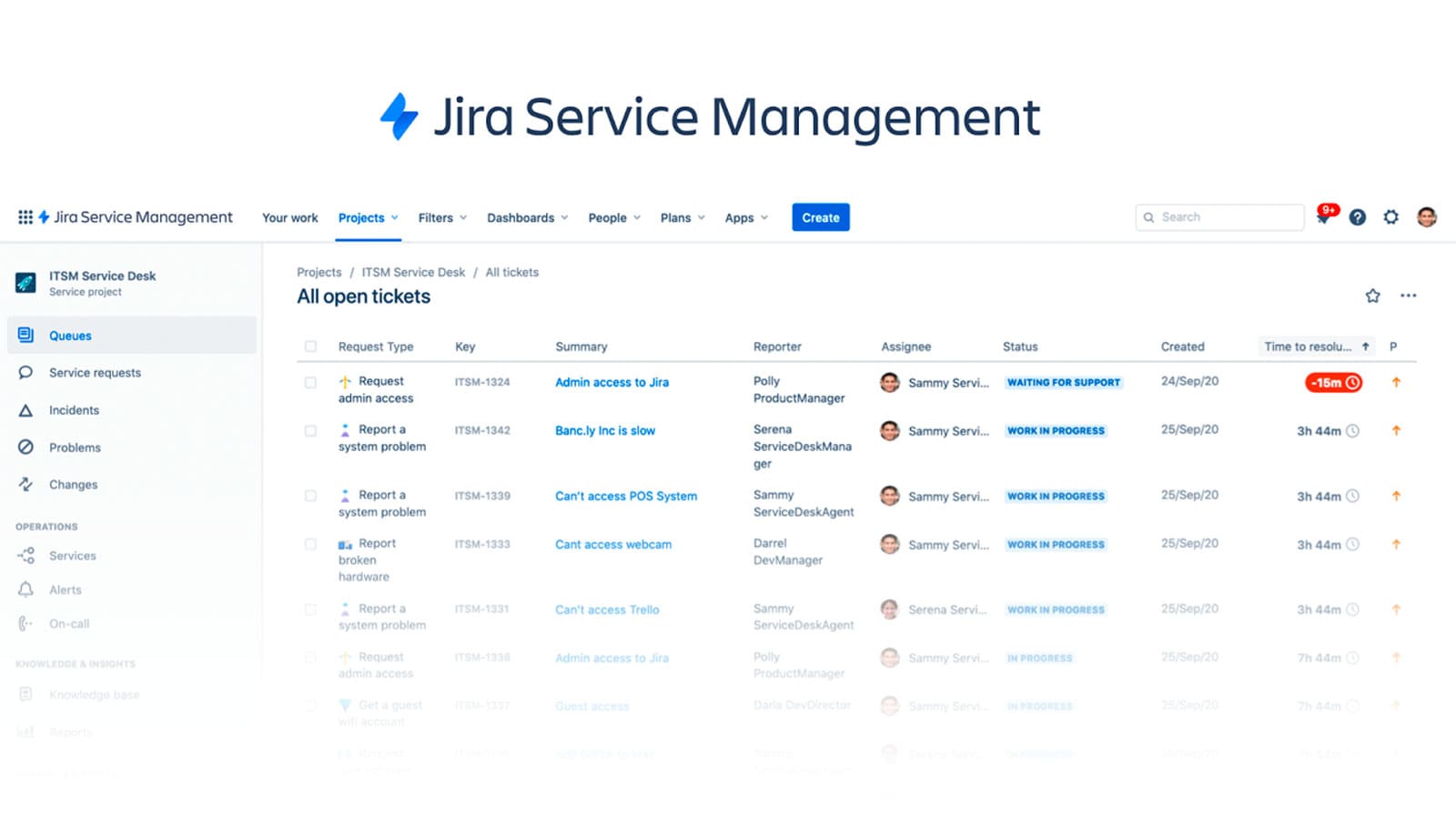
Developed by Atlassian, Jira Service Management is known for combining ITSM capabilities with DevOps practices. It’s particularly strong in organizations that already use Jira Software, since the integration makes it easy to align IT support with development workflows.
It’s a cloud-first platform but also offers a data center option for on-premise deployment.
Jira Service Management key features
These are some of the platform's functionalities according to the official features page (accessed November 2025).
- Request Management (self-service portal, request types).
- Incident Management (resolve disruptions, link with Dev/Ops).
- Configuration / Asset Management (view infrastructure, manage dependencies).
- Self-service and knowledge base.
- Automation & AI capabilities (on-call scheduling, alerting, and more).
Jira Service Management pricing details
It offers subscription-based plans with tiered pricing based on the number of agents.
- Free: Free for up to three agents.
- Standard: $19 per agent, per month.
- Premium: $48 per agent, per month.
Starting with 201 agents, you can contact the sales team to access the quote for the Enterprise plan. - Checked on: Nov 2025 (US), official web.
Jira Service Management user reviews and ratings
- Gartner Peer Insights score: 4.4
- G2 score: 4.3
4. SolarWinds Service Desk
SolarWinds® Service Desk is a cloud-based IT Service Management (ITSM) platform that adheres to ITIL best practices, offering a comprehensive suite for Incident, Problem, Change, and Release Management.
It is often used as part of the SolarWinds suite of IT Management tools, which also includes network monitoring, database management, and IT automation solutions.
SolarWinds features
According to their official documentation (accessed November 2025), these are some SolarWinds service desk features.
- Incident, Problem, Change, and Release Management workflows.
- Asset Management and CMDB (hardware inventory, license tracking).
- Self-service portal for employees to submit/search tickets.
- Real-time dashboards and analytics to monitor service desk performance.
- Multi-channel support and ITIL compliance.
SolarWinds pricing details
There are three pricing tiers for SolarWinds Service Desk.
- Essentials: $39 per month / per technician
- Advanced: $79 per month per technician
- Premier: $99 per month / per technician
- Checked on: Nov 2025 (US), official website.
SolarWinds user reviews and ratings
- Gartner Peer Insights score: 4.4
- G2 score: 4.3
5. SysAid
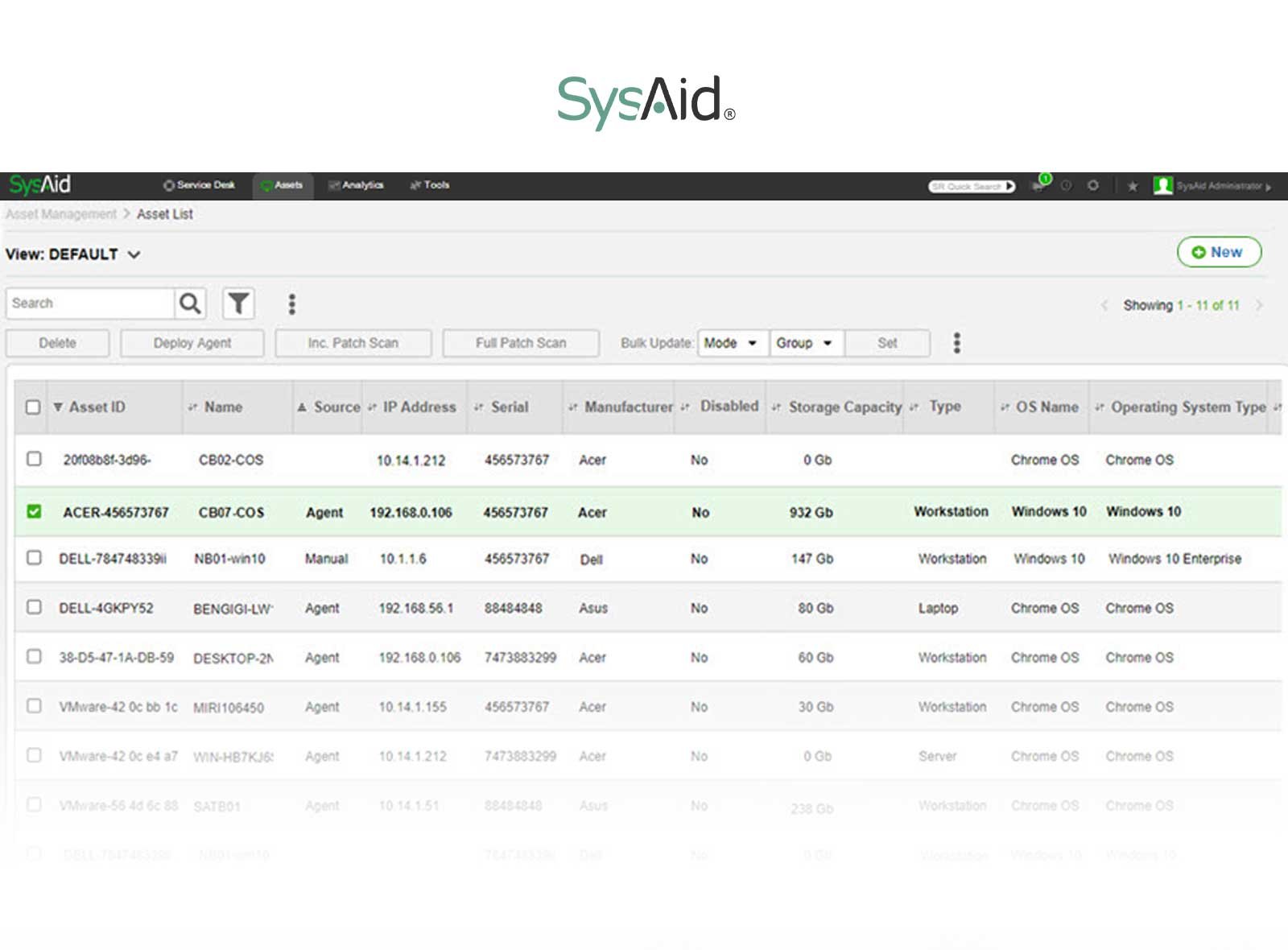
SysAid® is an ITSM platform offering help desk, Asset Management, and automation tools. It’s particularly strong in mid-sized companies that value customization and affordability.
SysAid has built a reputation for balancing ITIL-aligned functionality with practical tools for day-to-day IT operations.
SysAid features
According to the provider’s site (accessed November 2025), the platform delivers these capabilities.
- Full Asset Management tied into the service desk (hardware, software, cloud, IoT).
- Built-in AI agents for task automation.
- Ticketing and workflow automation with fast setup.
- Embedded CMDB and configuration visibility within tickets.
- Supports Incident, Problem, Change, Request, and Configuration Management.
SysAid pricing details
SysAid offers tiered pricing. Specific details are available upon request.
SysAid user reviews and ratings
- Gartner Peer Insights score: 4.6
- G2 score: 4.5
6. Freshservice
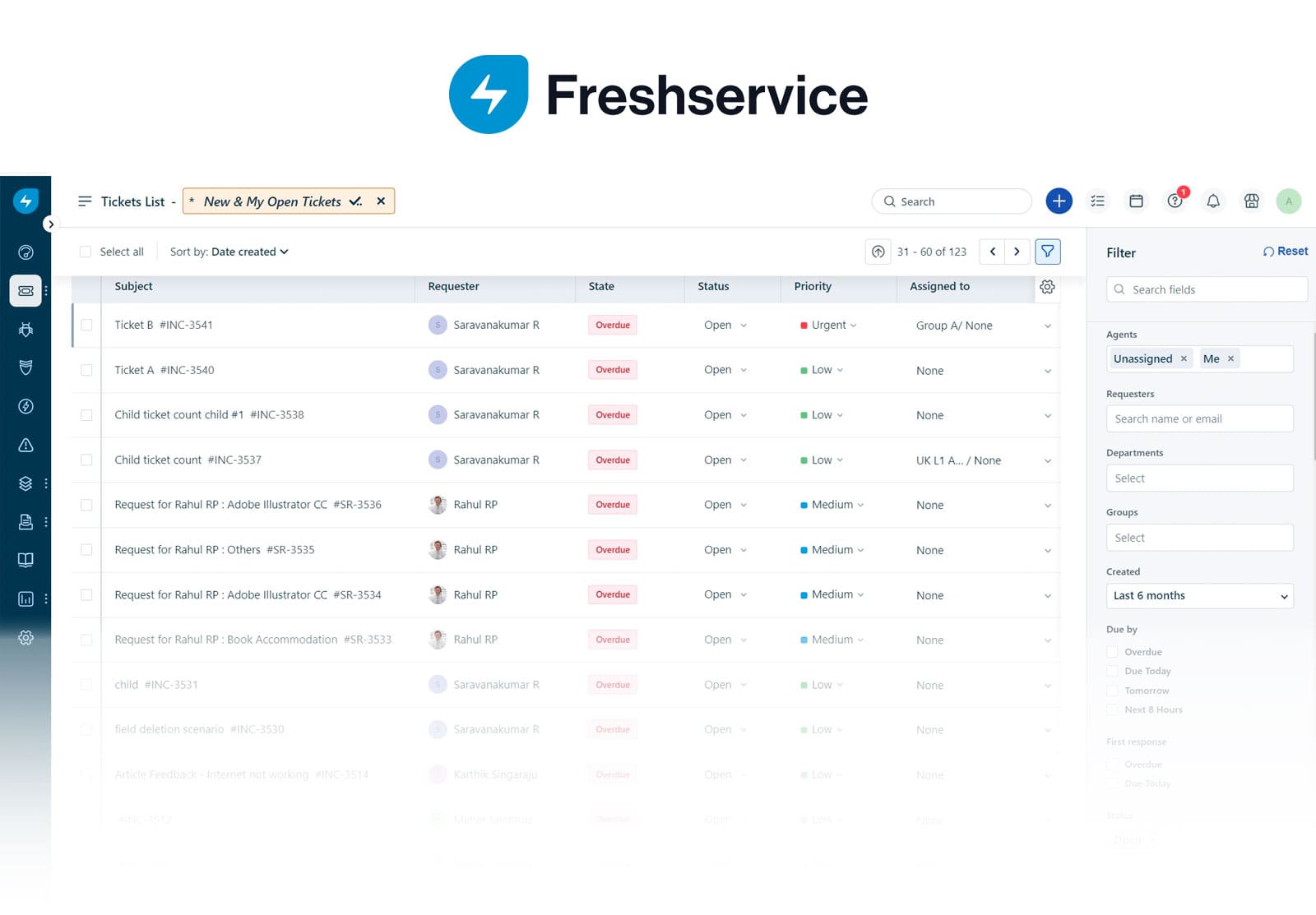
Freshservice®, developed by Freshworks, is a cloud-native ITSM platform designed with a strong focus on ease of use, quick implementation, and affordability. It integrates AI-driven automation to classify tickets, suggest solutions, and improve efficiency for IT teams.
Because of its intuitive design, Freshservice is often favored by organizations that want a straightforward ITSM solution with strong automation capabilities.
Freshservice features
The company’s product page (accessed November 2025) highlights these as part of the platform’s offering.
- Integrated IT Asset Management and IT Operations Management.
- AI-powered agents and workflows. Includes automated ticket assignment, categorization, and resolution recommendations.
- Enterprise Service Management support extends self-service and service catalog capabilities to HR, finance, and other business teams.
- Unified Configuration Management Database (CMDB).
- Omnichannel support.
Freshservice pricing details
It offers 3 subscription levels with published price, the prices with annual billing are:
- Starter: $19 per agent, per month.
- Growth: $49 per agent, per month.
- Pro: $99 per agent, per month.
The fourth tier, Enterprise, requires a quote. - Checked on Nov 2025 (US) official website.
Freshservice user reviews and ratings
- Gartner Peer Insights score: 4.2
- G2 score: 4.6
7. Ivanti Neurons
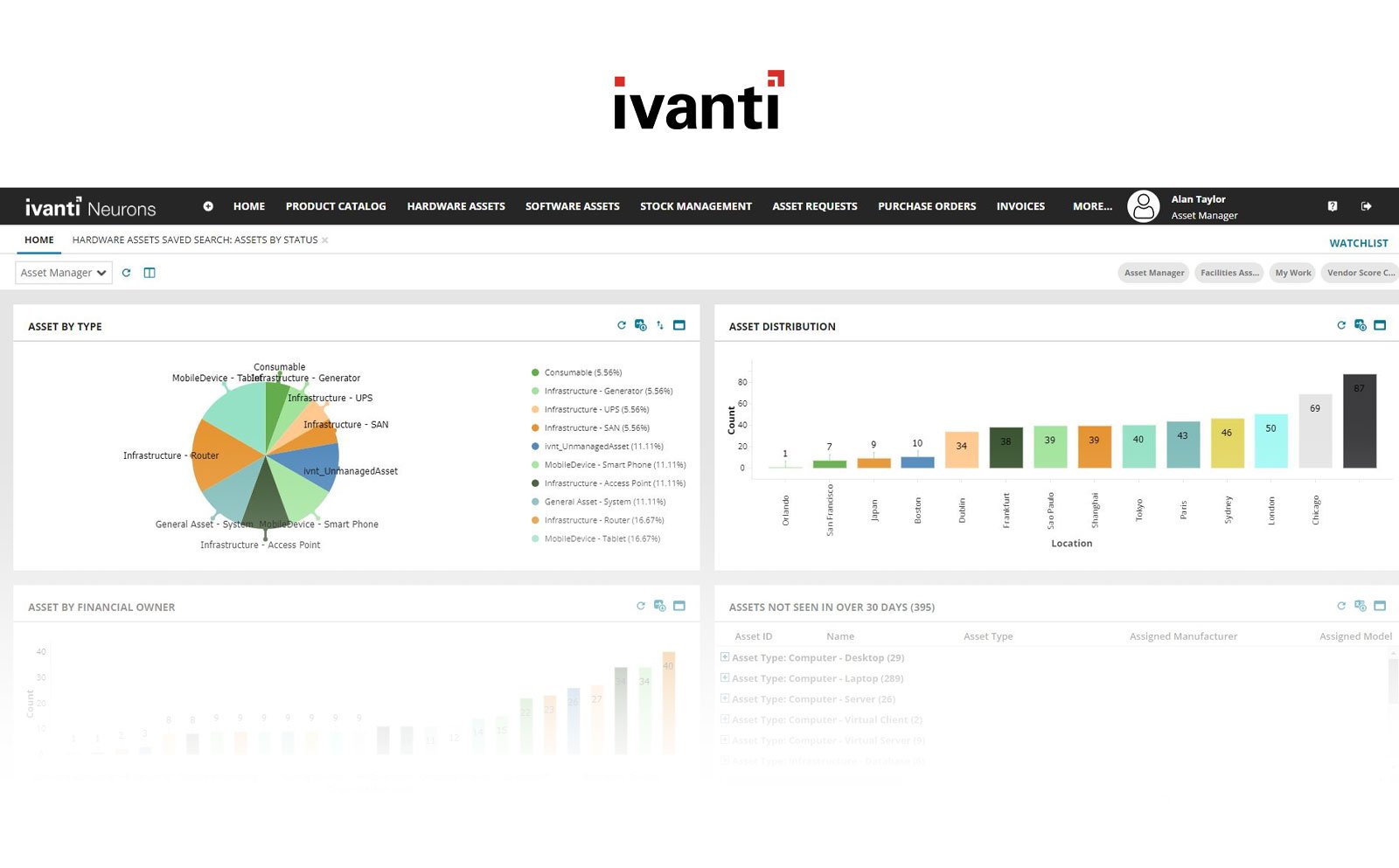
Ivanti® Neurons for ITSM is part of Ivanti’s broader automation and Endpoint Management suite. It stands out for combining ITSM with strong Endpoint and Asset Management capabilities, making it attractive to enterprises with complex IT estates.
One standout feature is automation: Ivanti markets as a “self-healing” platform (as they explain in this interview with SiliconAngle) that can proactively resolve issues.
Ivanti Neurons features
Here are some of the functionalities mentioned in the official features overview (accessed November 2025).
- Incident and Problem Management aligned with ITIL.
- Self-service portal and request fulfillment for users.
- Knowledge Management and automation to reduce manual tasks.
- Integration with wider Ivanti Neurons platform.
- Reporting and SLA Management.
Ivanti Neurons pricing details
Ivanti does not disclose its pricing. Users must request a quote based on deployment size and modules.
Ivanti Neurons user reviews and ratings
- Gartner Peer Insights score: 4.2
- G2 score: 3.9
8. BMC Helix ITSM

BMC Helix ITSM® is a suite of applications for creating, configuring, and managing IT Service Management requests and functions. The platform delivers in cloud, hybrid, or on-premise deployment options.
According to SoftwareAdvice, BMC Helix ITSM automates standard ITIL processes out of the box and offers configuration options to tailor applications to organizational needs. The solution enables IT Service Management, including customer support, Change and Release Management, and Asset Management.
BMC Helix ITSM features
Based on their official documentation (accessed November 2025), the platform supports these functionalities.
- Incident and Problem Management with context-aware routing.
- Change and Release Management with risk analytics.
- Asset and Configuration Management (CMDB).
- Digital workplace and service catalog with omni-channel access.
- Analytics and AI-driven automation, dashboards, natural-language narratives, cognitive automation for classification/assignment, and actionable insights.
BMC Helix ITSM pricing details
Pricing is customized based on organizational needs, with quotes provided upon request.
BMC Helix user reviews and ratings
- Gartner Peer Insights score: 4.3
- G2 score: 3.7
9. TOPdesk ITSM
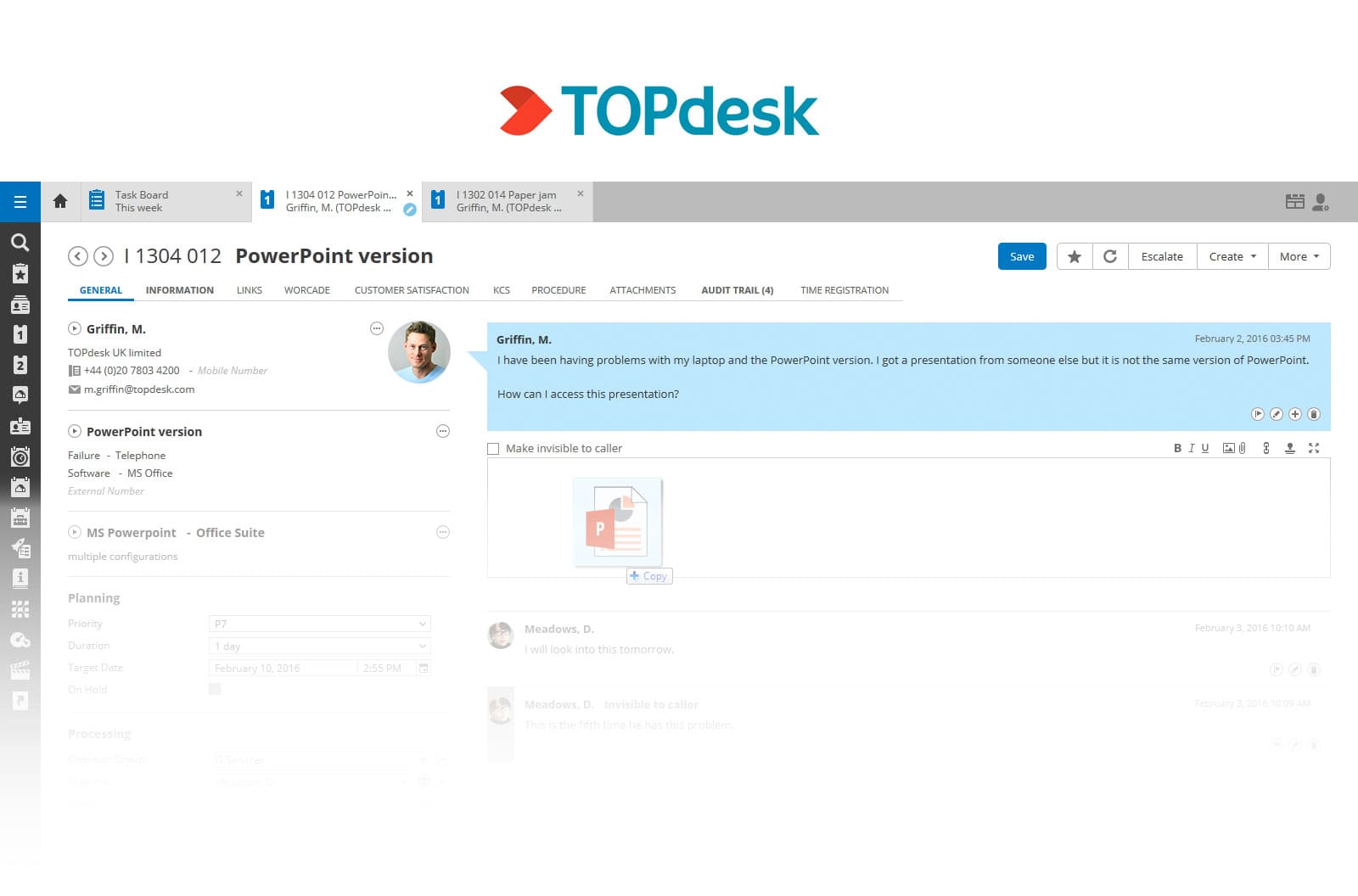
TOPdesk® is an ITSM solution developed in the Netherlands, designed to help organizations manage IT service requests, incidents, and changes. It also includes features for facilities and Enterprise Service Management, making it suitable for organizations that want to centralize multiple service functions. The platform can be deployed in the cloud or on-premises, depending on organizational needs.
TOPdesk features
According to official product information (accessed November 2025), the platform provides these key features.
- Incident, Change, and Request Management with workflow support, change planner, and automated notifications.
- Events and actions, triggers for automations.
- Self-service portal and feedback/survey capabilities.
- Customizable dashboards with KPIs to visualize service performance and customer effort.
- Contract and Service Level Management.
TOPdesk pricing details
TOPdesk's pricing is based on the number of agents and offers volume discounts. The rates below are for 50 agents:
- Essential: $58 per agent/month
- Engaged: $83 per agent/month
- Excellent: $114 per agent/month
For fewer than 50 agents, per-agent costs are higher. For example, the Essential plan costs $76 per agent/month for up to 10 agents and $68 per agent/month for up to 20 agents. For deployments exceeding 50 agents, users must request a custom quote.
- Checked on: Nov 2025 (US), official website.
TOPdesk user reviews and ratings
- Gartner Peer Insights score: 4.5
- G2 score: 4.2
10. TeamDynamix ITSM

TeamDynamix® ITSM is a Service Management platform that combines ITIL-aligned IT Service Management with Project Portfolio Management and enterprise automation. It’s designed as a no-code solution, allowing organizations to configure workflows and automate processes without development effort.
The platform can support both IT and business functions, offering a centralized system for managing requests, changes, and projects.
TeamDynamix ITSM features
The company’s product page (accessed November 2025) highlights these as part of the platform’s offering.
- No-code configurability.
- "AI Service Assist" for ticket deflection and faster resolutions.
- ITSM Asset Discovery with multiple sources and CMBD.
- Branded self-service portal and knowledge base support.
- Automation options with multiple pre-built connectors are available.
TeamDynamix ITSM pricing details
Specific costs are available upon request.
TeamDynamix user reviews and ratings
- Gartner Peer Insights score: 4.6
- G2 score: 4.4
11. EasyVista

EasyVista® EV Service Manager is a cloud-based ITSM suite built on ITIL best practices and enhanced with AI, designed to unify IT support, operations, and monitoring into a single platform. It covers core Service Management processes such as Incident, Problem, Change, and Service Request Management, and integrates Asset Management and dependency mapping for infrastructure visibility.
The software supports integration with other IT and business applications.
EasyVista features
These are among the tool’s main features, as stated on its official page (accessed November 2025).
- ITIL / ITSM process coverage: Incident, Problem, Change, Service Request.
- AI-driven automation.
- Integrated Asset Management with automated discovery.
- No-code customizable workflows.
- Contract and License Management.
EasyVista pricing details
Pricing is quote-based and depends on the number of agents and modules.
EasyVista user reviews and ratings
- Gartner Peer Insights score: 4.6
- G2 score: 4.2
12. ManageEngine ServiceDesk Plus

ManageEngine ServiceDesk Plus is a Service Management platform developed by Zoho Corporation that combines ITSM, IT Asset Management, and CMDB capabilities. It’s available both on-premises and in the cloud, offering flexibility for different infrastructure needs.
The solution is built around ITIL-based processes and supports service delivery for both IT and non-IT teams. It’s widely used by organizations seeking a single system for Request Management, asset tracking, and change control within a customizable interface.
ManageEngine ServiceDesk Plus features
These are some of the platform's main features based on information from their official product page (accessed November 2025).
- Incident Management module for full lifecycle ticketing.
- Asset Management and CMDB: discover, map, monitor assets & relationships.
- Self-service portal, live chat, mobile app, and knowledge base.
- Change and Release Management with workflow automation.
- AI capabilities (conversational virtual agent, GenAI).
ManageEngine ServiceDesk Plus pricing details
Pricing is available in both cloud subscription and perpetual licensing models. Plans vary based on the number of agents and modules.
Cloud pricing tiers:
- Standard: Starts from $13 / technician / month
- Professional: Starts from $27 / technician / month
- Enterprise: Starts from $67 / technician / month
Note: For Professional and enterprise tiers, price changes also according to the amount of assets. There are also available add-ons.
- Checked on: Nov 2025 (US), official website.
ManageEngine ServiceDesk Plus user reviews and ratings
- Gartner Peer Insights score: 4.4
- G2 score: 4.2
In closing
Do you need more help to choose the right IT Service Management tool for your organization? We have plenty of resources for you! Make sure to take a look at this free ITSM RFP template, a guide for you to ask all the right questions to potential vendors.
Plus, we have a great support team to guide you through the whole process! If you don't believe us, you can ask them yourself. Just schedule a call with our experts (with no strings attached).
Disclaimer: All product names, logos, and brands are property of their respective owners. All company, product, and service names used on this site are for identification purposes only. Use of these names, trademarks, and brands does not imply endorsement. Comparisons are based on publicly available information as of November, 2025 and are provided for informational purposes only.












